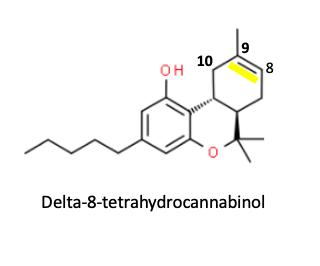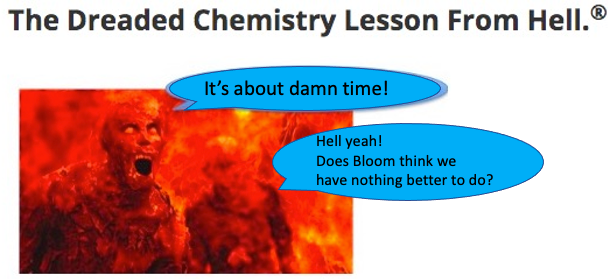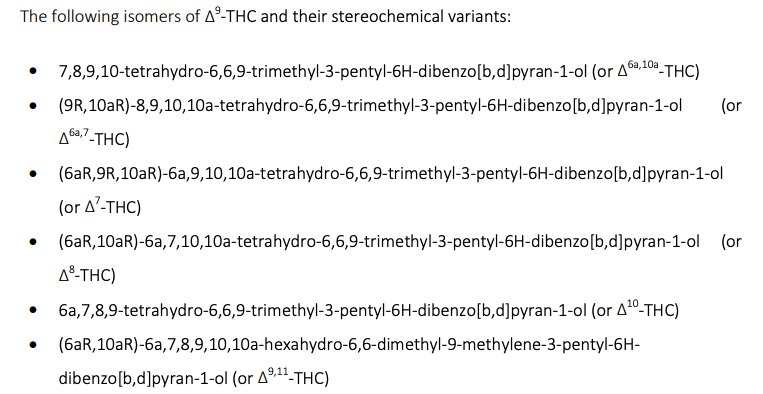
For those who follow our bizarre concoction of drug laws, it should come as no surprise that they are both ineffective and also woefully ill-equipped to keep up with new (sometimes) legal analogs that even a marginally trained chemist can do. As I wrote about fentanyl analogs, chemistry, specifically synthetic organic chemistry (1), can easily be used to get around the law.
Rather than bore you with a tome about the legality of marijuana and marijuana chemicals, I thought I'd bore you with a chemistry lesson instead. Get ready. Here it comes! It's been a while, so I made this one especially incomprehensible. Let TDCLFH® begin!

Nomenclature - The bane of our existence
Chemistry nomenclature, the tedious process of naming chemicals, is a baffling array of multiple naming systems, dozens of different names for the same chemical (2), and incomprehensible rules. This can be illustrated quite "nicely" by looking at how delta-8 THC, a chemical that has recently been in the news, gets its name. This should give you a pretty good idea of why nomenclature drives chemists nuts. (For clarification, you should know that delta-9 – the primary THC isomer in marijuana – is commonly known as THC. The names are interchangeable)
What Does the 8 in Delta-8 Mean?
If you have any propensity toward anxiety or self-harm, you might want to skip this. The figures below show the (apparent absence of) logic behind the number 8. Figure A (left) starts off making at least some sense.
Each carbon is assigned a number, which is necessary for assigning a name to a unique structure. The carbon atom at 12:00, which is attached to a hydroxyl group (green square), is called #1. From there, proceeding counterclockwise, the numbers assigned to the next carbon atoms increase logically – 2, then 3, then 4. Then 5, right? Nope.

Figure B shows that the position after #4 is ... #10b (blue). Huh? How can this be? Answer: you don't want to know. Continuing, #5 gets assigned to the oxygen atom next to 10b. No big deal. We're still pretty much following a backward clock, so there is some logic remaining. But not much.
(Mercifully ending this wretched lesson) Figure C shows that the carbon atom after #6, like #10a, makes no sense. Instead of being called #7, it's 6a (blue). Why? Once again, don't ask. A degree of sanity returns after this. Carbon #7 shows up next on the clock dial (4:00) and is followed by 8 and then 9. This is where the "delta-8" comes from. Greek letters are used to describe the position of double bonds (yellow line). The same holds true for dietary supplements, for example, omega-6 or omega-3 fish oils. Delta-8 means that the double bond exists between carbon atoms 8 and 9. The delta part is beyond the scope of this article. Be thankful for this.
And, if this wasn't sufficiently horrifying to have you opening up Amazon to order Final Exit, it can be worse. There is a 69-page document put out by the WHO titled "Isomers of THC." If you're looking for a little light reading this is as good as it gets. Take a look at this especially enthralling passage:

Ah, chemistry. Source: WHO, Isomers of THC
Seriously, who cares?
Both marijuana users and law enforcement care, otherwise I would not have dragged you through this hideous exercise. The position of that double bond determines both the pharmacological properties and legality of the chemical. The chemical properties of delta-8 and delta-9 THC (the "normal" THC in marijuana) are nearly identical, as are their chemical structures. The only difference in structure is the position of the double bond (yellow).

Pharmacology
As you'd expect, when two molecules are so similar they act similarly on the receptors in the brain. This is largely true, although there are subtle differences between the two. Delta-8 has a similar psychotropic profile to THC but is thought to be less potent. Relatively little is known about this drug because it arrived on the scene only recently and because cannabis and CBD oil contain only trace amounts of the chemical, so there wasn't enough around to isolate and study until an unnamed chemist figured out how to make it.
Chemistry to the "rescue"
Two years ago I wrote about the chemical difference between CBD and THC – one chemical bond – and whether it was feasible to use CBD as a source for THC. (It isn't – the reaction that was used gave a mess (a complex mixture containing many impurities).

HPLC trace of psychoactive substances formed by reacting CBD with dilute acid. There are at least four impurities present. Source: Cannabis and Cannabinoid Research Volume 1.1, 2016 DOI: 10.1089/can.2015.0004
But the chemist found that a different set of conditions enabled CBD could be converted not to THC, but to delta-8 THC, which spawned a cottage industry in the stuff (3). This chemistry is explained on the subtly named site Hempvada. Why do I think that their annual board of directors meeting looks something like this?

Hempvada BOD meeting? Photo: Flickr
A quick visit to the Hempvada site shows (unsurprisingly) that they are peddling CBD products. With a flair! Here are some of them:
- CBD Sunrocks 65%
- Flavored CBD Oil Tincture
- Santa Maria CBD Hemp Flower
- CBD Beard Oil
- Sour CBD Gummies
- CBD Energy Shots and CBD Oil Bundle
- CBD Sea Salt Scrub, Bath Bombs, and PM Facial Moisturizer Bundle (Seriously?)
Legal matters
Delta-8 was synthesized because it was previously "unknown" and therefore (possibly) legal. Or maybe it isn't. This depends on where you are and how drug laws are interpreted. It's a complicated mess. I haven't the bandwidth (or intellect) to go into the myriad of often contradictory laws governing the use of marijuana and its chemicals, but Jon Jackson writing for Newsweek and Bill Weinberg on the Project THC site do a very nice job of explaining this complex topic.
Signing off
For all both of you who have made it through TCDHFH® as well as the rest of this somnorific article, congratulations! Most humans would have taken one look at the nomenclature section alone and hastily switched over to reading prescription drug inserts. Feel free to reward yourself. Perhaps chow down on some pot brownies. Just keep in mind that what you're getting might not be so pure.

An HPLC trace of an extract of cannabis brownies. The damn things have more chemicals in them than the Gowanus Canal. Source: Sigma-Aldrich
NOTES:
(1) Synthetic organic chemistry is the science of converting one substance to another by the use of known reactions. It is the basis of much of drug discovery.
(2) I wasn't kidding. All of the following are legitimate names for delta-9 THC. There are 136 of them. Is it any wonder that chemists are thought of as some yet-to-be-defined, but aberrant species?
- (-)-δ9-trans-Tetrahydrocannabinol
- Δ9-Tetrahydrocannabinol
- Δ9--THC
- (-)-trans-δ9-Tetrahydrocannabinol
- (-)-trans-δ9-THC
- (-)-δ 9-Tetrahydrocannabinol
- (-)-δ9-Tetrahydrocannabinol
- (-)-δ9-Tetrahydrocannabinol
- (-)-δ9-THC
- (-)-δ9-trans-Tetrahydrocannabinol
- (6aR,10aR)-6,6,9-Trimethyl-3-pentyl-6a,7,8,10a-tetrahydro-6H-benzo[c]chromen-1-ol [ACD/IUPAC Name]
- (6aR,10aR)-6,6,9-Trimethyl-3-pentyl-6a,7,8,10a-tetrahydro-6H-benzo[c]chromen-1-ol [German] [ACD/IUPAC Name]
- (6aR,10aR)-6,6,9-Triméthyl-3-pentyl-6a,7,8,10a-tétrahydro-6H-benzo[c]chromén-1-ol [French] [ACD/IUPAC Name]
- 1972-08-3 [
- 625-153-6
- 6H-Dibenzo(b,d)pyran-1-ol, 6a,7,8,10a-tetrahydro-6,6,9-trimethyl-3-pentyl-, (6aR-trans)-
- 6H-Dibenzo[b,d]pyran-1-ol, 6a,7,8,10a-tetrahydro-6,6,9-trimethyl-3-pentyl-, (6aR,10aR)- [ACD/Index Name]
- 6H-Dibenzo[b,d]pyran-1-ol, 6a,7,8,10a-tetrahydro-6,6,9-trimethyl-3-pentyl-, (6aR-trans)-
- Dronabinol
- Dronabinolum [Latin]
- Δ9-THC
- Marinol [Trade name]
- Marinol (TN)
- MFCD00083207 [MDL number]
- Tetrahydrocannabinol [Wiki]
- δ(9)-Tetrahydrocannabinol
- δ1-Tetrahydrocannabinol
- δ1-THC
- δ-9-TETRAHYDROCANNABINOL
- δ9-THC
- δ9-THC
- (-)- δ 9-Tetrahydrocannabinol
- (-)-(6aR,10aR)-6,6,9-trimethyl-3-pentyl-6a,7,8,10a-tetrahydro-6H-benzo[c]chromen-1-ol
- (-)-3,4-trans-δ1-Tetrahydrocannabinol
- (-)-trans-δ 1-Tetrahydrocannabinol
- (-)-trans-δ 9-Tetrahydrocannabinol
- (-)-trans-δ 9-THC
- (-)-trans-δ1-Tetrahydrocannabinol
- (-)-trans-δ9-Tetrahydrocannabinol
- (-)-δ 1-Tetrahydrocannabinol
- (-)-δ 9-Tetrahydrocannabinol (δ9-THC) 100 µg/mL in Methanol
- (-)-δ 9-Tetrahydrocannabinol (δ9-THC) 1000 µg/mL in Methanol
- (-)-δ 9-THC
- (-)-δ 9-trans-Tetrahydrocannabinol
- (-)-δ(sup 1)-3,4-trans-Tetrahydrocannabinol
- (-)-δ(sup9)-trans-Tetrahydrocannabinol
- (-)-δ1-Tetrahydrocannabinol
- (-)-δ1-Tetrahydrocannabinol
- (-)-δ9-(trans)-Tetrahydrocannabinol
- (-)-δ9-Tetrahydrocannabinol solution
- (10R,10aR)-6,6,9-Trimethyl-3-pentyl-6a,7,8,10a-tetrahydro-6H-benzo[c]chromen-1-ol
- (6aR,10aR)-3-amyl-6,6,9-trimethyl-6a,7,8,10a-tetrahydrobenzo[c]chromen-1-ol
- (6aR,10aR)-6,6,9-trimethyl-3-pentyl-6a,7,8,10a-tetrahydrobenzo[c]chromen-1-ol
- (6aR,10aR)-6,6,9-trimethyl-3-pentyl-6H,6aH,7H,8H,10aH-benzo[c]isochromen-1-ol
- (6aR,10aR)-6a,7,8,10a-Tetrahydro-6,6,9-trimethyl-3-pentyl-6H-dibenzo(b,d)pyran-1-ol
- (6aR,10aR)-6a,7,8,10a-Tetrahydro-6,6,9-trimethyl-3-pentyl-6H-dibenzo[b,d]pyran-1-ol
- (6aR-trans)-6a,7,8,10a-Tetrahydro-6,6,9-trimethyl-3-pentyl-6H-dibenzo(b,d)pyran-1-ol
- (L)-δ 1-Tetrahydrocannabinol
- (l)-δ(sup 1)-Tetrahydrocannabinol
- (l)-δ1-Tetrahydrocannabinol
- (L)-δ1-Tetrahydrocannabinol
- 1-trans-δ 9-Tetrahydrocannabinol
- 1-trans-δ(sup 9)-Tetrahydrocannabinol
- 1-trans-δ(sup9)-tetrahydrocannabinol
- 1-trans-δ(sup9)-tetrahydrocannabinol
- 1-trans-δ9-Tetrahydrocannabinol
- 1-TRANS-δ-9-TETRAHYDROCANNABINOL
- 3-Pentyl-6,6,9-trimethyl-6a,7,8,10a-tetrahydro-6H-dibenzo(b,d)pyran-1-ol
- 6,6,9-Trimethyl-3-pentyl-7,8,9,10-tetrahydro-6H-dibenzo(b,d)pyran-1-ol
- 6,6,9-Trimethyl-3-pentyl-7,8,9,10-tetrahydro-6H-dibenzo[b,d]pyran-1-ol
- 6aR,7,8,10aR-tetrahydro-6,6,9-trimethyl-3-pentyl-6H-dibenzo[b,d]pyran-1-ol
- 6H-Dibenzo(b,d)pyran-1-ol, 6a,7,8,10a-tetrahydro-6,6,9-trimethyl-3-pentyl-, (6aR,10aR)-
- 6H-Dibenzo(b,d)pyran-1-ol, 6a,7,8,10a-tetrahydro-6,6,9-trimethyl-3-pentyl-, trans-
- 6H-Dibenzo[b, d]pyran-1-ol, 6a,7,8,10a-tetrahydro-6,6,9-trimethyl-3-pentyl-
- 6H-Dibenzo[b, d]pyran-1-ol, 6a,7,8,10a-tetrahydro-6,6,9-trimethyl-3-pentyl-, (6aR-trans)-
- 6H-Dibenzo[b, d]pyran-1-ol, 6a,7,8,10a-tetrahydro-6,6,9-trimethyl-3-pentyl-, trans-
- 6H-Dibenzo[b,d]pyran-1-ol, 6a,7,8, 10a-tetrahydro-6,6,9-trimethyl-3-pentyl-
- 6H-Dibenzo[b,d]pyran-1-ol, 6a,7,8,10a-tetrahydro-6,6, 9-trimethyl-3-pentyl-, (6aR-trans)-
- 6H-Dibenzo[b,d]pyran-1-ol, 6a,7,8,10a-tetrahydro-6,6,9-trimethyl-3-pentyl-, trans-
- 81586-39-2 [RN]
- Cannabinol, 1-trans-δ(sup 9)-tetrahydro-
- Cannabinol, 1-trans-δ(sup9)-tetrahydro-
- Cannabinol, δ1-tetrahydro-
- Cannabinol, δ1-tetrahydro-
- Deltanyne
- Exocyclic δ (9)(11)-Tetrahydrocannabiol
- https://www.ebi.ac.uk/chebi/searchId.do?chebiId=CHEBI:66964
- Δ9-THC (CRM)
- Δ9-THC-d3 (CRM)
- Δ9-THC-d9 (exempt preparation)
- L-trans-δ 9-Tetrahydrocannabinol
- L-trans-δ9-Tetrahydrocannabinol
- L-trans-δ9-Tetrahydrocannabinol
- L-δ 1-trans-Tetrahydrocannabinol
- L-δ1-Tetrahydrocannabinol
- l-δ1-trans-Tetrahydrocannabinol
- L-δ1-trans-Tetrahydrocannabinol
- Marinol®
- Maxepa
- Primolut
- Syndros
- Tetrahydro-6,6,9-trimethyl-3-pentyl-6H-dibenzo(b,d)pyran-1-ol
- Tetrahydro-6,6,9-trimethyl-3-pentyl-6H-dibenzo[b,d]pyran-1-ol
- Tetrahydrocannabinol δ9
- Tetranabinex
- THC
- trans-6a,7,8,10a-Tetrahydro-6,6,9-trimethyl-3-pentyl-6H-dibenzo(b,d)pyran-1-ol
- trans-δ (-)-9-Tetrahydrocannabinol
- trans-δ 9-Tetrahydrocannabinol
- trans-δ9-Tetrahydrocannabinol
- trans-δ9-Tetrahydrocannabinol
- δ 1-Tetrahydrocannabinol
- δ 1-THC
- δ 9-Tetrahydrocannabinol
- δ 9-THC
- δ 9-trans-Tetrahydrocannabinol
- δ(1)-Tetrahydrocannabinol
- δ(9)-Tetrahydrocannibinol
- δ(9)-THC
- δ(sup 1)-Tetrahydrocannabinol
- δ(sup 1)-thc
- δ(sup 9)-tetrahydrocannabinol
- δ(sup 9)-thc
- δ(sup9)-THC
- δ1-Tetrahydrocannabinol
- δ1-Tetrahydrocannabinol (VAN)
- δ1-THC
- δ9-Tetrahydrocannabinol
- δ9-Tetrahydrocannabinol
- Δ9-tetrahydrocannabinol
- δ9-Tetrahydrocannabinol (VAN)
- δ-9-THC
- δ-9-THC
- Δ9-THC
- δ9-trans-Tetrahydrocannabinol
- δ9-trans-Tetrahydrocannabinol
(3) Chicago Sun Times: "An unregulated, weed-like drug dubbed ‘CBD on crack’ has spiked in popularity. Now the legal pot industry is calling for a crackdown."



